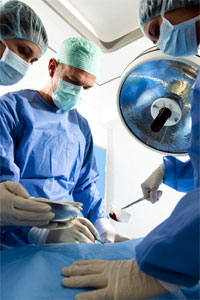Can I Get a Flat Stomach After a Hysterectomy?
![]() I have been told by friends that because I had a hysterectomy that I will not be able to obtain a flat stomach as they cut the muscles for this surgical procedure. Is this true?
I have been told by friends that because I had a hysterectomy that I will not be able to obtain a flat stomach as they cut the muscles for this surgical procedure. Is this true?
![]() Many people complain about weight gain after a hysterectomy, attributing it to the surgical procedure. Whether your stomach appears flabby after your hysterectomy may depend on the type of hysterectomy you needed and surgical technique used to perform it. The surgeon may have performed the hysterectomy entirely through the vagina, known as a Total Vaginal Hysterectomy or TVH. He may have made small incisions with the assistance of a laparoscope to remove the uterus and cervix. In this case, he may not have incised abdominal muscles that would leave a scar.
Many people complain about weight gain after a hysterectomy, attributing it to the surgical procedure. Whether your stomach appears flabby after your hysterectomy may depend on the type of hysterectomy you needed and surgical technique used to perform it. The surgeon may have performed the hysterectomy entirely through the vagina, known as a Total Vaginal Hysterectomy or TVH. He may have made small incisions with the assistance of a laparoscope to remove the uterus and cervix. In this case, he may not have incised abdominal muscles that would leave a scar.
If the hysterectomy was performed by cutting abdominal muscles to remove the uterus, he would have made an incision about eight inches long in the lower abdomen or stomach area. An abdominal hysterectomy would leave a scar that might make your stomach appear flabby and looking a little like a pouch.
Hysterectomies can be a little difficult for women to cope with because they usually take place at the time a woman’s metabolism begins to slow down. This often happens in mid-life, when women may develop issues like cervical cancer or uterine fibroids that cause pain and other problems.
 It can be hard to completely flatten the stomach after a hysterectomy, but steps can still be taken to reduce the stomach’s annoying, flabby appearance. You might have water retention after the procedure, which can cause your stomach to appear bloated. Drinking more water keeps you hydrated. It reduces bloating in the stomach as well.
It can be hard to completely flatten the stomach after a hysterectomy, but steps can still be taken to reduce the stomach’s annoying, flabby appearance. You might have water retention after the procedure, which can cause your stomach to appear bloated. Drinking more water keeps you hydrated. It reduces bloating in the stomach as well.
Make sure your diet is balanced with an adequate amount of fruits, vegetables and lean protein. Modify the amount of food you eat, especially since the metabolism tends to slow down after a hysterectomy. Avoid gas-producing foods like baked beans, broccoli, cabbage and Brussels sprouts so as not to aggravate the bloating you may experience after the surgery.
Eat more high fiber foods, but introduce them into your diet slowly. Oatmeal and wheat bread are excellent sources of fiber, but introducing them too quickly might cause problems like gas production. Adding them gradually into your diet allows your body to adapt to the fiber and begin digesting them as quickly as possible so that your stomach does not get bloated.
In regards to exercise, Yoga and other abdominal exercises help to strengthen the core muscles and tighten up the stomach. Try using several different exercises to hit a range of areas in the midsection. Here are a few recommended ones to try out:
- Exercise Ball Crunches
- Crunches
For the traditional crunch, lay down on a mat, bend your knees and cross your arms in front of your chest. Slowly lift your shoulders towards the ceiling and crunch up using your abs. If crunches are not for you, schedule a daily walk to get some good cardio exercise in. A 45-60 minute walk every day helps to tone up your lower body and burn calories.
In addition, wearing a belly or compression wrap can help to get your stomach back to pre-hysterectomy shape. Girdles can help to reduce the appearance of flabbiness, as they contain lycra that provides extra abdominal support. A hysterectomy may make you seem overweight and flabby, but changes to your lifestyle can help to reduce body fat and flatten your stomach.
-
How Do I Flatten My Stomach with Abdominal Workouts?
My inquiry is regarding my abs workout. I do 20 minute
-
How Can I Lose 50 Pounds in a Year?
I had been exercising using a personal home gym system
-
Should I Use Meal Replacement Powders and Protein Bars?
I’m about to start a weight training program and
-
Diet for malabsorption syndrome?
Diet for malabsorption syndrome? complications d
-
How Can I Build Muscle and Add Size To My Triceps?
I train my entire body during my weekly workouts and I
-
How Many Sets Should I Do for Butt Shaping Exercises?
I just started college about 3 months ago and I have a
- DON'T MISS
- What is a Good Bulking Diet Plan for Building Muscle Mass?
- Why people gain weight even if they eat less?
- Will Weight Training Make Girls Big and Bulky?
- Why am I Working Out But Not Losing Any Weight?
- Does drinking almond milk help you lose weight?
- How Can I Get a Bigger and Rounder Butt?
- Does lemon water burn fat in stomach?
- How do you get rid of love handles?
- How Can I Slim Down My Hips and Thighs?
- Am I Overtraining My Biceps and Triceps When I Workout?




